|
Part Six:
Wow
or Adventures in the
Unknown
or on Foot, on Animals, on
Firm Ground, Maybe!

Where have we been? It has been a long trip, yet
enjoyable and restful. We have seen much, explored more, and
wondered at the things that are beyond our intellect. We
began (as your guide I remind you) with an ordered, balanced
world, ABA. We boarded boats which never seemed to meet
other boats or go forward as a fleet, although we could see
that many of us docked at the same place on islands. Our
shelters seemed to always have room for only one to two
passengers. The mists enclosed more and more of the scene as
we moved toward a termination point. In Part Five, we got a
glimpse of a cliff which must be attached to a mountain
somewhere ahead. On the side of the cliff was a reminder of
the ABA form that we started with, with two green clumps of
evergreens around a cluster of pink blossoms and leaves
(trees which loss their leaves in the winter and come back
strong in the spring). The numbers two and three have been
our companions as much as the other human beings, the
mountains, the trees, the lake and the mists. Basically, we
have been upon a Southern Sung trip across the lake country
of South China.
"... he allowed himself to be swayed by his convictions
that human beings
are not born once and for all on the day their mothers give
birth to them, but that life
obliges them over and over again to give birth to
themselves."
Gabriel Garcia Marquez, Love in the Time of Cholera
"There is really nothing you must be,
And there is nothing you must do
There is really nothing you must have
And there is really nothing you must know.
There is really nothing you must become. However, It helps
to understand
that fire burns and when it rains, the earth gets wet..."
Manabu Foljamaris

Orientation: The other day, while watching "Inside the Actors Studio" from Pace University, the moderator
James L. Lipton asked his guest, Johnny Depp, about “What
you would like St. Peter to say when you come to the “Pearly
Gates." Depp was quick to answer with one explosive word,
“Wow.” Your guide feels that way each time we leave the
Southern Sung lake scene and are shocked into a Northern
Sung “high view” scene of mountains, waterfalls, hidden
temples, paths along precipices and cliffs, and bridges over
deep valleys. The one word that this guide would use, that
jumps immediately into his mind, when he is presented with
this view, is “WOW!” It is almost too much to take in with
one viewing. At first, it seems that all that we have seen,
traveled by and known is gone.
Rule Nine: Peace is not a
destination but a mode of travel. It is a center
within oneself that moves a person away from strife and
outside the destructive conflict.
How can we have peace of mind and spirit when we are thrust
into an environment that is totally unlike anything that we
have experienced before. While on Guam, I took a friend from
a small island off the main one of Ponape to Guam. I took
him out to lunch in one of the new Japanese hotels. He had
never seen such luxury or interior space. After lunch I wished
to show him the island of Guam and its beach front from a
height so we got on an elevator. When the doors opened, he
backed to the wall, stating: “Where did the restaurant go?
Where did the beach go that I could see out the window?”
Gently, I took him over to the balcony overlooking the lobby
and pointed out the restaurant far below on the first floor.
Then just as gently, we walked to the huge viewing window on
the fifteenth floor and we looked down at the beach like a
tapestry of patterns that contrasted with the green-blue sea
spread out for miles in front of us. Much later, back in his
village, he told the Rubaks, the wise elders (which I was
made an honorary member in the following year) about his
adventure in that hotel and what he had seen.
Time to analyze this kind
of experience: 1) you are disoriented, 2) you
back off so that you can get your bearings, 3) you accept or
not accept the new experience, and 4)if you are willing to
take risks you embrace the newness and learn from it.
Sometimes, you need to be moved (or shocked) out of your
comfort zone in order to “see” a new, magical experience.
For instance, instead of saying, “The light at the end of
the tunnel”, which is a normal phrase in common practice,
you name something (here it is a television show for science
fiction) “The Tunnel at the End of the Light.” If the bears
came to the house of the three Goldie Locks sisters, instead
of visa versa, and sat, ate and slept there, we would be
surprised. Surprise can be a welcomed mild shock. In any
creative viewing, like this Ming Dynasty hand scroll, it is
important to clean out the mind that any change of scenery
comes suddenly and instantly. We need this instant
juxtaposition of environments so that we can see old friends
(water, mountains, mists, trees, temples and people) with a
refreshed point of view. Jokes are like that: such as, “What
is big and purple and swims in the ocean?” The answer: “Moby
Grape!”
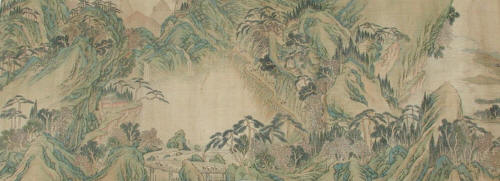
Let us thin slice this last section of our journey of the
hand scroll:
Wow, a surprise. Northern Sung Mountains. A new
adventure-all different?
Cliffs, mountains, no lake anymore, but waterfalls.
Travel on foot or on horseback plus a need for servants.
Around the mountain, up the cliff trails and across the
bridge.
Final (maybe) resting place. A two-tier temple.
Hole of mist. Center of attention.
Old friends (trees, shelters, mountains, people and
mists) revisited.
Unknown is known yet unknown still.
Artists, especially Ming painters, like to surprise us,
their audience. If there is not a natural transition, they
will make an abrupt change. It is like listening to Ravel’s
Bolero over a period of time with a day scene of flowing
notes, rolling sounds and a heartbeat rhythm. All at once,
just as we begin to find contentment in that experience, we
are instantly transported to the Boston Pops playing the
1812 Overture with cannons exploding and fireworks lighting
the night sky on the Fourth of July. The transition from a
Southern Sung lake trip to the Northern Sung mountains is
such a journey of contrasts.
If you do not have friends that surprise you, sometimes a
writer makes up an imaginary friend. Such a friend for the
job of MY GUIDE is Bubba Jay, married to a Waco Indian by
the name of Hummingbird Rose. The name Bubba Jay normally is
associated with “red neck” and “cowboy” in Texas folklore. I
wanted my imaginary friend to be a contrast to that
stereotype and that is why I created a liberal,
sound-thinking, maverick artist (who listens to classical
music, has shown at the Museum of Modern Art in New York
city and loves ballet). Bubba is my imaginary friend that I
go to when I need advise, centering and rational
observations. He is someone that helps me find “peace of
mind."
Story: What the L! It has been over a year and a
half since I drove down the road previously called Dripping
Springs to the house by the Brazos River, owned by Bubba Jay
and his wife Hummingbird Rose. In many ways, it has been too
long a time to be out of contact with such a close friend.
After greeting Bubba, sitting down to a tall, cool beer,
Hummingbird Rose and my wife, Anne, went to the kitchen to
talk of things that they had bottled up for some time and
had to uncork. Bubba Jay and I open our own bottle of
questions.
“You look thinner and not in pain,” Bubba started the
conversation as if it were but a moment since we last met.
“You see, although I have not seen you in the flesh, I still
read your articles. The one on pain was interesting. I
thought after reading it that I might have to attend your
wake instead of a friendly visit like this.”
“Yes, as you grow older,” I answered, “you find that the
vehicle of your body needs some overhauls. Pain gets in the
way of inner peace.”
“You know what I say to that, ‘What the “L." We live longer
by the ‘L’s’. You know something,” continued Bubba, “there
are ‘L’s’ that sustain us. Love, laughter and luck leads to
longevity.”
“I agree,” I said, suddenly smiling, thinking about his
statement and reflecting on the scene of us sitting there
outside with the Brazos River running along a few yards from
where we sat. “If it had not been for Anne in the Republic
of Georgia last year, I do not believe that I could have
taken the days when the American Embassy announced that Chechnyans were plotting to kidnap Americans in Tbilisi. As
you know, the war between Russia and Chechnya was only
ninety miles from where I taught. We were forced to do
everything together for protection sake but after years of a
continuing honeymoon that was normal anyway for us. Love is
the first thing that keeps you young, that helps you find a
safe place inside yourself. Also, if we could not have
laughed a lot in the shelter of our barred apartment, it
would have been unbearable to stay for nine months.”
“Don’t forget luck,” said Bubba seriously, “no one survives
anyplace without luck. I have a young friend who just turned
34 and he has been diagnosed with Huntington’s Disease. It
has plagued his family. Each member gets it when they turn
40. He has no luck in terms of his genes. In contrast, you
are lucky. Some would say that you are the luckiest person
on the face of the earth. You see, I watched a Lou Gehrig
movie the other night on my new television.”
“You now have television?” I said with a quiver of surprise
in my voice. “In Georgia, we had no radio or television but
I did not miss them. And you know how I love to go to sleep
watching some television show that does not interest me.” “I
know,” said Bubba. “We decided, in today’s world, there are
times when we need to know some things and television does
it faster than print media. Not better, just faster.
Hummingbird Rose and the kids love the game shows.”
“Do you think that just living a long time is good?” I
asked. Bubba smiled again, “It is better than the
alternative.” “OK, then, what the ‘L’s’ give us is worth the
time that we spend questioning the value of growing old but
there are days when the body is not up to the same energy
level as the spirit,” I commented, almost to myself. “Yes,”
said Bubba, suddenly far away and looking out over the
simmering surface of the Brazos River, “we know three things
about ourselves on this journey of life. We are born. We
live. We die. The middle is the only one where we have an
glimmer of a choice and the ‘L’s’ educate us to navigate
those troubled waters.”
Hummingbird Rose and Anne came out at that moment and asked,
“Who wants to match wits with the contestants of Jeopardy?”
“Sure,” Bubba and I said laughing, welcoming the break,
“What the L?”
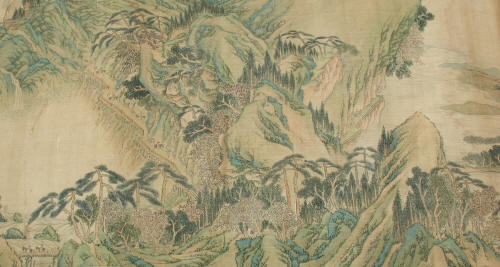
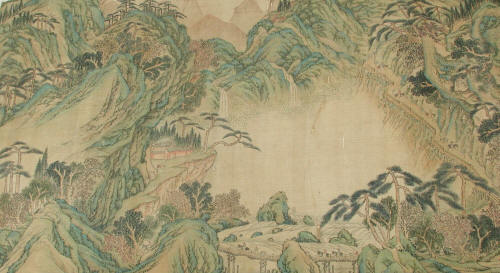
As your guide, I must tell you,
“This is the most important scene of them all but it has the impact or
meaning for us because we drifted on the lake for as long as
we did.”
Again, let’s take it apart: In the top left hand
corner is three (3) faint mountains; below this, in the
lower left corner is three (3) trees with two umbrella of
leaves above (2); to the right of the open hole of the mist
is a sequence of two (2) then three evergreens (3); in front
of this is two sections (2) of a bridge, cut in half by a
diminutive mountain; and on each section are two travelers
(a master and a servant) (the master on horseback and the
servant carrying bundles across his shoulders) (2 + 2). In
the center is the mist, the product of two (2) waterfalls.
By the temple (1) with two levels (2), made up of three
sections on the bottom (3) and two sections on top (2) stand
two travelers, watching three Evergreen trees (3), the two
waterfalls (2) and above them, three faint mountains (3) in
the distance.
And in the middle of all
this, in the center of this massive array of growing green
things, rocks and dots to define their roundness, dragon
spines on the mountains, number sequences that we were
introduced to long ago, trails that lead us here, fellow
companions to share the vistas, and mists that are formed by
the two waterfalls are:
a Center of Mist, Nothing, a
Circle, ZERO and yet Contentment and PEACE.
It is refreshing to find others who have discovered this
sense of peace, perspective and distance from all kinds of
professions:
Coleridge told the story of seeing all the lines for
Kubla Khan during an opium trip but he could only remember a
seventh of those when he “came down” from being “high."
Marcel Proust talks of finding the whole idea for
Remembrance of Things Past in watching someone drink a cup
of tea and the thread of the novel unwound.
Michael Jordan remembers “being in the zone” and seeing
the whole basketball court in one instance, knowing exactly
what he was to do and how he would score when the basket
looked much larger than it actually was. So does Tiger Woods
see the hole as great well at times, when he is putting.
Robert Wilson works all night drawing ideas for plays
that last seven days (in Iran), or seventeen to nineteen
hours (on six continents, which were to come together in Los
Angeles for the 1984 Olympics but never materialized). We as
his audience cannot possibly journey through all his data
and make a decision where it will end. What it means, we
learn as we watch and listen, is the journey of discovery is
the message. His collaborator, Philip Glass, when working
with Wilson on Einstein on the Beach, made this observation:
“We don’t know what it means. We just created it!”
Joseph Campbell reflects upon knowing that he would win
when he ran track in college by seeing himself more
energized and in that position (in an interview with Bill
Moyer). He wrote about the “hero with a thousand faces”
later with that same sureness when approaching the
unknown. He knew when he was a child that myth and legend
were his theater, his remembrance, his playing field and his
life’s work. His advice to his students about approaching
the unknown (for them "a life decision") was "Follow your
bliss!"
Rule Ten: Bliss is a
centering of self therefore to find self “Follow your
bliss.”
I guided you across the bridge of time and space, broken in
this last scene by a small mountain (which some might call
“a boulder”) where each of our travelers was helped by a
servant who carried their master’s load. I pointed out that
above the small mountain we see three rocks in a row (3) and
two rocks below (2).
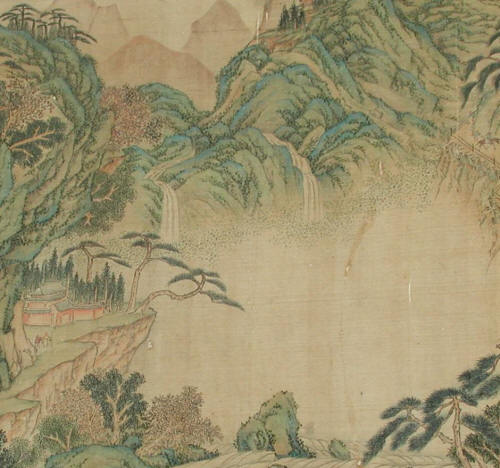
We thought, at first, when coming into this new adventure
in the high mountains of a Northern Sung scene that all was
changed but the longer we stayed in this place (this
darkening chamber of uniqueness) we found friends who we had
visited many times before (green and colored trees,
traveling companions, water (now in the form of a
concentration of mist from two waterfalls) and the dark of
the Unknown (which now seemed light to our eyes).
On this trip, we journeyed with those who know about “the
wheel of changes” and the knowledge that it is best to be in
the center where no more changes happen. There in that place
of no movement we find a centering of self and peace.

On some of our stops to reflect, we collect works of
art from the Ming Dynasty to help us see other scenes that
might illuminate our journey. Here are two:
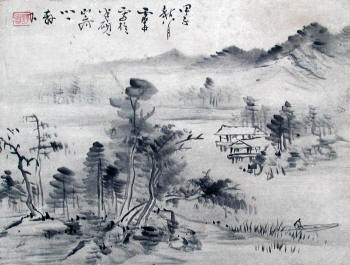

We recorded our observed similarities and the
differences, weighing their importance to our understanding
of this one journey of peace. We always came back to the
Ming Dynasty hand scroll of a trip across a lake of
time to the mountains
of place and the
mystery of space (the void
and the mists).
We left the unknown and now come home to the unknown.

My last job on this journey, as your guide, through this
diverse but unified landscape of substance and fluid, real
and virtual, is to rewind the scroll so that we can revisit
where we have been, what we have seen and learned. As your
guide, I point out in passing backward, a row of trees that
repeat 2, 3, 3, 3,3 and below that a cluster of trees with
three (3) trunks and two umbrella (2) of pine needles.
Standing on the mountains, we have seen the centennials of
pointed, green pines that guarded our way. We have tried,
unsuccessfully, to decipher the tien fa and the number of
strokes that make up the pine needles on each branch. In
this complexity, no one has all the answers (some admit
there may not be answers). We share stories, comments and
our journeys. Along the way, we make observations:

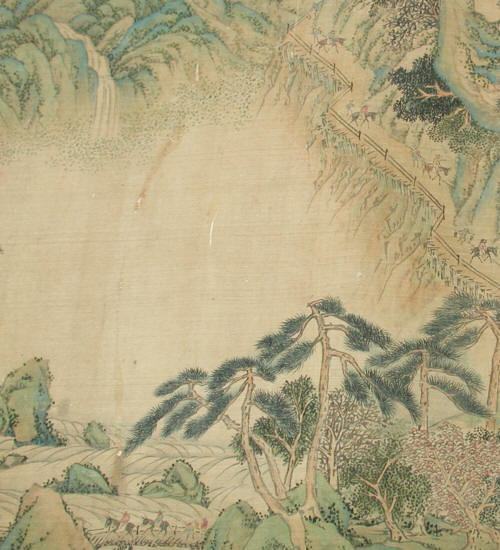
such as: above the bridge, cut into two sections, are
four rocks (three together then one apart) and on them is
tien fa, dots, which are a microcosm of how all the rocks
are formed. Here we see this sequence of dots:
Rock One: nine dots total in groups of 3,
3, 1 with 2 below.
Rock Two: six dots total in groups of 1,
3, 2.
Rock Three: five dots in groups of 2, 3.
Rock Four: seven dots in groups of 3,1,3.
What does it all mean? I do not know. At times, over
these 300 viewings, I have wondered if anyone knows. We do
know that the travelers were out of sight for a time as they
journeyed behind the mountain on foot and reappeared on
horseback with servants to help them carry their burdens.

So now, that we are rewinding
the Ming Dynasty hand scroll to its beginning, you have seen
much, experience much, and learned that any journey may not
have one destination at the end but many or seemingly none
(which is a journey in itself into the UNKNOWN). After 300
trips on this lake, journeying in these mountains
(figuratively and finding real ones to explore), I find that
there are times when I do not want to know THE ANSWER to my
question, “Where does this voyage lead?” The journey has
been enough. The mist in the question leads me to center
myself and find peace of spirit and mind.
Are you jealous of the ocean’s generosity?
Why would you refuse to give
this joy to anyone?
Fish don’t hold the sacred liquid in cups!
They swim the huge fluid freedom.
Jelaluddin Rumi 1207-1273
What have you found on this
trip? What trips of peace can you tell us about? How did you
journey? Where did it take you? Who did you ask to travel
with you and why?
Is the Unknown as much fun for you as it has been and will
be for me? Send us your comments, stories of peace and
answers.
A Guide’s Note:
As a traveler on this journey, you may have noticed that I
stopped enhancing the late images and gave you the gray
image that had natural, aged silk as a background. Silk when
it is first used and painted upon is white; with age, it
becomes a brownish gray. I enhanced the early images (the
background turned a light yellowish tint) so that I could
give my fellow travelers a clean view of the details of
their trip. Once they had mastered those elements, the
enhancing was no longer necessary. In fact, the mystery of
the unknown is enhanced itself by the darkening of the
surface. Things are not read as easily and therefore it
takes time to see them. It is the story of life.
|

